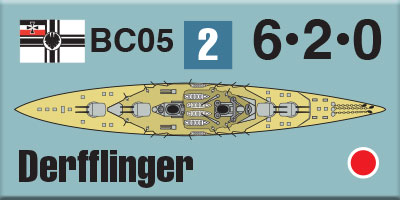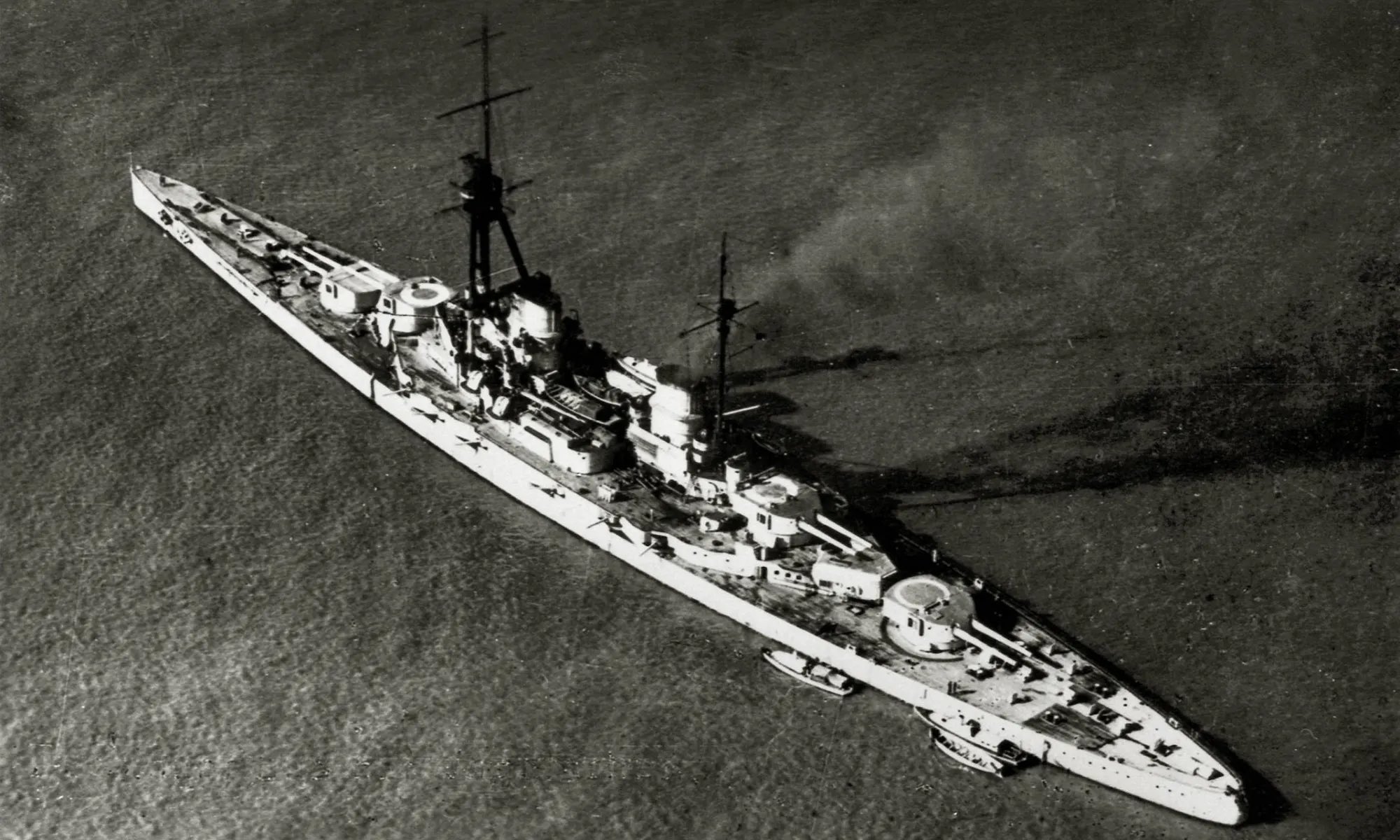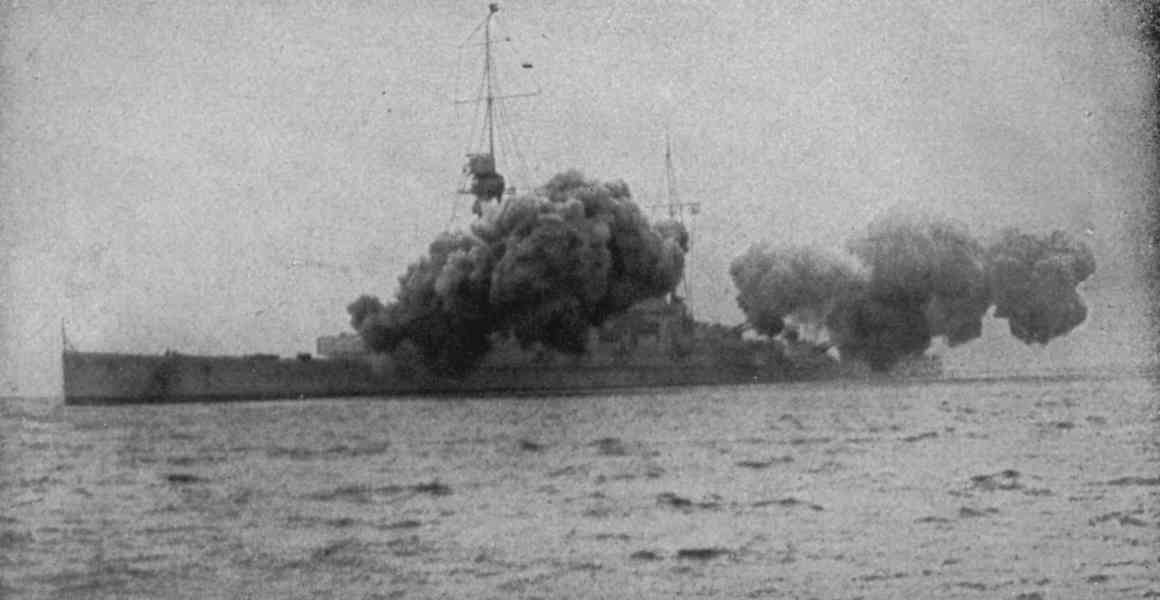| Jutland:
The Iron Dog: SMS Derfflinger
By Mike Bennighof, Ph.D.
March 2023
 During discussion over the shape of the Imperial German Navy’s 1910 battle cruiser, which would become Seydlitz, the Construction Department offered several alternatives for the new ship before State Secretary (the head of the Imperial German Navy) Admiral Alfred von Tirpitz selected an enlarged example of the previous class. During discussion over the shape of the Imperial German Navy’s 1910 battle cruiser, which would become Seydlitz, the Construction Department offered several alternatives for the new ship before State Secretary (the head of the Imperial German Navy) Admiral Alfred von Tirpitz selected an enlarged example of the previous class.
One of the other two Seydlitz finalists changed the ship’s main armament from ten 280mm guns in five twin turrets to eight 305mm guns in four twin turrets. The other kept the 280mm guns, but moved all five turrets to the ship’s centerline.
For the 1911 battle cruiser, initially labelled Great Cruiser K, Tirpitz at first favored a repeat of Seydlitz. He stubbornly insisted on retaining the 280mm gun and adopting diesel propulsion, but eventually his department chiefs convinced him that the 280mm weapon would not penetrate the armor of the new British Lion-class battle cruisers, and that diesel technology simply was not yet ready to propel major warships.
Senior Naval Architect Hans Hüllman produced sketches for a new ship with four turrets along the centerline. In one version, the turrets were closely grouped in two super-firing pairs fore and aft; in the other one of the turbine rooms separated the two aft turrets. She was a strikingly attractive ship, and would instantly become the most expensive vessel ever laid down in a German shipyard.
The naval architects also pointed out that for a minimal increase in displacement, they could add a fifth, amidships turret and keep Great Cruiser K’s speed and battleship-level protection (unknown to them, Sir Philip Watts had proposed the same for the battle cruiser Lion, giving her the same firepower as the Orion-class battleships). Great Cruiser K would be the equal of the new König-class dreadnoughts, just much faster. Tirpitz demurred, citing cost increases and also the need for battle cruisers not to equal the fighting power of battleships.

Derfflinger seen in 1916.
That seemingly insane statement reflected the political reality of late Imperial Germany. Battleships and cruisers had separate funding lines under the series of German Naval Laws that authorized warship construction. If the types converged and fulfilled the same missions, Tirpitz feared, then the Reichstag might eliminate one of the funding lines in the next Naval Law. Therefore, Great Cruiser K could not carry the same armament as the König class. The new ship would carry eight rather than ten heavy guns, in a deliberate choice to build a less powerful ship.
Great Cruiser K was duly ordered to Hüllman’s design and laid down in March 1912 at Blohm und Voss, which had built every German battle cruiser to that point. She would receive the name Derfflinger upon her launch in July 1913.
Derfflinger exhausted the original authorization for six great cruisers, which meant that the next battle cruiser would be (in budgetary terms) a replacement for the old protected cruiser Kaiserin Augusta. The money had started to run out, and the Imperial Naval Office, which oversaw spending, decreed that the 1912 battle cruiser could cost no more than the 1911 ship: 32.3 million marks, with any overruns covered by public subscriptions raised by the German Naval League.

Ersatz Kaiserin Augusta was laid down just six weeks after Derfflinger, in May 1912, and would be formally named Lützow when launched in November 1913. While Blohm und Voss had built every German battle cruiser through Derfflinger, Tirpitz awarded the contract for Ersatz Kaiserin Augusta to Schichau, Danzig in a raw political move. Danzig was a stronghold of the left-wing Progressive People’s Party (FVP), and the battle cruiser project represented many new jobs for the party’s trade union base. The FVP wasn’t a large party, but the January 1912 general election had given the Socialists – no friend to Tirpitz’s battleship dreams - the largest bloc in the Reichstag but not a majority (under the German system, the Reichstag had limited powers and did not form coalitions or name government ministers, but did control government budgets). Moving a mid-level party from opponent to supporter represented a major win for Tirpitz’s cause.
The High Seas Fleet would pay a price for Tirpitz’s maneuver. War broke out before he could make use of the FVP’s votes, while Schichau proved far less efficient in building a complicated new type of ship than Blohm und Voss. Lützow’s construction may have begun only six weeks after Derfflinger, but she joined the fleet a full eleven months after her sister. She would be missed at Dogger Bank.
For the 1913 Great Cruiser, a replacement for the old protected cruiser Hertha, the Construction Department proposed a series of improvements that would increase the ship’s speed, increase the size and number of torpedo tubes and lengthen the central armored citadel to accommodate the larger power plant. That meant greater cost, and Tirpitz rejected the improved battle cruiser – but did request sketches and specifications for an improved Derfflinger carrying 350mm rather than 305mm guns.

The Iron Dog at Scapa Flow, sometime post-war.
The increased cost for heavier guns proved too much for Tirpitz, but he did allow a handful of minor improvements for the new ship. Otherwise, Ersatz Hertha would be a third sister for Derfflinger. She was laid down in October 1913, this time at the Imperial Shipyard in Wilhelmshaven, and launched in August 1915, when she received the name Hindenburg in honor of the victor of Tannenberg the previous year. The war had broken out in August 1914, and wartime shortages of material and labor meant that the new cruiser did not join the fleet until May 1917.
Derfflinger blew through her budget, ending up costing 56 million marks. Lützow ran 58 million marks and Hindenburg 59 million. The High Seas Fleet did receive very capable ships for the taxpayers’ (and donors’) money.
Derfflinger outweighed the previous battle cruiser, Seydlitz, at 26,600 tons’ displacement against 25,000 for the older ship. She would be 10 meters longer than Seydlitz but actually draw slightly less water. Where Seydlitz had been powered solely by coal, Derfflinger had a mixed power plant, with fourteen coal-fired boilers and four more burning oil. As in the older battle cruisers, the coal-fired boilers would later be fitted with an oil spray to increase the heat generated.
That arrangement represented a hard-fought compromise. The Construction Department noted that oil-fired boilers took up less space and required far fewer personnel to operate but did not acknowledge the greater energy output of oil per ton of fuel. Coal bunkers provided part of the ship’s protective scheme, and perhaps most importantly coal could be produced in Germany where oil had to be imported and might not be available in wartime.
Despite the changes in armament layout and propulsion, Derfflinger retained the same armor protection scheme as Seydlitz. Derfflinger was built without the transverse bulkheads of previous German warships, relying solely on her longitudinal frames and support hinges for hull strength (this method had been used in civilian liners for decades). Like the previous ship, she proved capable of taking enormous punishment: she would be hit 31 times at Jutland and survived. The scheme did have a weakness understood by her designers, that damage to her forecastle could allow in water that could not easily be pumped out. That flaw would sink her sister Lützow at Jutland.

Derfflinger after Jutland, June 1916. Note the shot away 150mm gun barrels.
Derfflinger carried the same 30.5cm SK L/50 rifles as the German dreadnoughts of the Helgoland, Kaiser and König classes. These gave better penetration than the British 12-inch gun, and not much less than the British 13.5-inch weapons of the newest Royal Navy battle cruisers with a considerably faster rate of fire. The twin turrets were similar to those of the König class, with slightly thinner armor.
Like Seydlitz, Derfflinger carried a secondary armament of a dozen 150mm guns in an armored casemate amidships. Her two sisters each carried fourteen. She had four torpedo tubes, all mounted under the waterline for the then-standard 500mm torpedo; her sisters were fitted for the new, larger 600mm torpedo.
Derfflinger exceeded her contract speed on trials, running at 26.5 knots rather than the expected 25.5. Because of the war, she did not run the same deep-water measured mile as the earlier battle cruisers and did so at full draught, both of which probably helped reduce her speed results.
The German East Asia Cruiser Squadron had rotated its crews during the summer of 1914, and the core of Derfflinger’s crew came from the men returned to Germany from their year aboard the armored cruisers Scharnhorst and Gneisenau. That gave Captain Ludwig von Reuter (who later became the High Seas Fleet’s final commander) an experienced, well-trained cadre supplemented by new recruits. She appears to have been a happy ship from the start, with good accommodations though the captain’s cabin on the bridge lacked its own head.

The Iron Dog fires a broadside.
Derfflinger had not finished fitting out when war broke out on 1 August 1914; Reuter asked to finished the job early so that his ship could join the First Scouting Group. She underwent trials and gunnery training in the Baltic and joined the High Seas Fleet in mid-November. Derfflinger took part in all of the First Scouting Group’s subsequent actions, escaping with little damage at Dogger Bank. She earned her nickname “Iron Dog” at Jutland, supposedly from the British but more likely from her own crew. She would be scuttled in Scapa Flow after the war, on Reuter’s order; she was the last ship to be scrapped, floating upside-down throughout the entire Second World War.
Lützow had only a short service life, joining the First Scouting Group in March 1916. She fought at Jutland on the last day of May, apparently firing the shell that caused the British armored cruiser Defence to explode. But in the course of eight catastrophic minutes, she suffered four 12-inch hits from Invincible and Inflexible: two shells each struck the bow and forward broadside torpedo rooms. The damage to these weak points allowed water to pour in where it flooded the armored bow section and could not be pumped out. Lützow went down slowly by the bow until her propellors were exposed and she could no longer make way. Captain Victor Harder ordered his crew to abandon ship; they left behind six men trapped in the forward dynamo room who maintained telephone contact with the bridge until the last officers left the ship. In recognition of his handling of Lützow’s last hours, Harder received command of the new fleet flagship Baden and he took most of his surviving crew with him to his new command.

Scuttling Hindenburg. June 1919.
Hindenburg, the last major warship completed by Imperial Germany, did not join the fleet until August 1917 and was not fully operational until October. She was present at the Second Battle of Helgoland Bight a month later, but did not engage the British battle cruisers. Hindenburg took part in all of the High Seas Fleet’s operations for the remainder of the war. She would be scuttled at Scapa Flow and raised for scrapping in 1930.
Derfflinger gave the High Seas Fleet very good service; like all German battle cruisers, she suffered from manufacturing defects in her turbines throughout the war and from the poor-quality coal provided to the High Seas Fleet. Lützow only lasted six weeks with the First Scouting Group, while Hindenburg only joined for the war’s last year. Lützow might have had a greater impact had she been ordered from a more efficient yard and been available for Dogger Bank and the other early-war operations, while Hindenburg’s construction suffered from labor shortages and low priority for materials.
Order Jutland second edition here.
Please allow an extra three weeks for delivery.
Sign up for our newsletter right here. Your info will never be sold or transferred; we'll just use it to update you on new games and new offers.
Mike Bennighof is president of Avalanche Press and holds a doctorate in history from Emory University. A Fulbright Scholar and NASA Journalist in Space finalist, he has published a great many books, games and articles on historical subjects; people are saying that some of them are actually good.
He lives in Birmingham, Alabama with his wife, three children, and his new puppy. His Iron Dog, Leopold, could swim very well.
Want to keep Daily Content free of third-party ads? You can send us some love (and cash) through this link right here.
|
